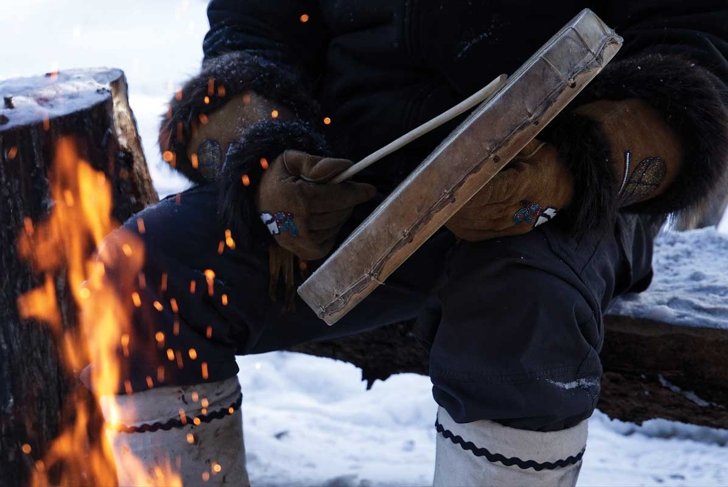
The seasonal traditions of Indigenous Peoples are as diverse as the Indigenous cultures across Canada. At the heart of our beliefs, the care and wellness of the collective is given more credence than individual needs. This may seem counterintuitive in a mainstream culture that focuses on the individual. But “the circle first” is not counter to self-wellness. In the least.
Indigenous cultural traditions—origins
Imagine the time before European contact. All spring, summer, and fall you’ve hunted, harvested, and preserved foods. You’ve been to international gatherings and marriages, and you’ve gone on trading expeditions. Your family has just moved to the winter camp to shelter from harsh weather. Winter is the season of reflection, to enjoy extended family, for restoration, and a time to share stories.
One-of-a-kind ceremonial or wedding regalia for family members will be crafted from hides you have tanned or wool you have harvested and spun. Embellishments on each outfit will speak of the essence of the wearer. With each stitch or turn of the loom, you’ll keep your thoughts light and happy, so that the wearer will always be lighthearted.
There is finally time for weaving baskets for cooking, storage, and carrying; for making gifts for summer giveaways; and for crafting unique works of art. It’s also time for fashioning tools and weapons for the coming hunting and tanning seasons and for preparing items for trade.
On the West Coast, you’ll be looking forward to hosting other villages for your winter ceremonies. In the Arctic, you’ll be preparing for ice hunting, traditional strength games, and drum dances, while on the Plains, you’re anticipating round dances.
To the East, you’re looking forward to longhouse gatherings. And on the East Coast, you’re readying the hunt for caribou, moose, and small game to supplement the seafood you collected earlier. Everywhere, there are bone and stick games for entertainment and for honing your skills for the summer gatherings to come.
Changes imposed by colonization
Colonization has had a dramatic impact on our diverse cultures and our wellness. The imposition of a Western paradigm on our traditional belief systems and worldviews affected cultural expression, spirituality, traditional Indigenous governance, connection to the land, and perhaps the most challenging, our healing.
Cultural resurgence
Treasures retained across our diverse Indigenous, Métis, and Inuit cultures restore a deep sense of hope as we witness a massive cultural resurgence.
- Ceremonies that were made illegal for decades now thrive.
- Colourful and lively intertribal powwow culture is enjoyed across North America all year round.
- Near-extinct languages have given birth to “Language Nests” for preschoolers.
- Elders’ teachings and wisdom is treasured.
- Children are carefully nurtured to enhance innate gifts that benefit
We cherish our times together: reconnections are made richer with much laughter and gentle teasing. Together, we slow to be in the moment; we have a place; are free to be our true selves; are accepted unconditionally; and can heal from the past and look to a better future.
We have preserved our ceremonies, oral traditions, storytelling, and perhaps most importantly, our belief that the wellness of all is essential to the well-being of the individual. We understand that …
- the whole creates a living, tangible web of energy to which each is connected
- when one is struggling, we all feel the strain
- when one is joyous, it lifts us all
Therefore, we have always nurtured one another, cared for one another, shared burdens and wealth, and continue to celebrate and mourn collectively.
To this day, when there is a loss, we collect money to give the family, so that costs are shared. Potlatches on the coast and “giveaways” across this land are about sharing wealth among all. And when we gather, we laugh; we enjoy each other. We may cry at the gravesite, but enter the after-feast smiling and ready to celebrate our departed loved ones’ life.
What might we learn from Indigenous ways of being?
How could these Indigenous ways breathe life and shift winter holidays for all of us? We have a choice to discard former expectations: the huge (perfect) family gatherings with elaborate meals. We can leave behind the stress from our perfect turkey cooked dry and our hope for healing family rifts that dissolved into discord.
Instead, we can choose to …
- be authentic—with ourselves, with everyone
- realize that we’re individuals but that we’re inexorably connected to everyone in our world
- understand that caring for the collective is self-care
Perhaps holding smaller, intimate gatherings with simple fare will allow you to give loved ones the dedicated time and attention you’ve longed for during the pandemic. Consider gathering with your larger circle in a simpler way, such as with an open house where people are free to come and go. Invite those in your circle to bring their favourite dish to share. Share burdens; share joy.
According to our ancient stories, this is the healing we need for our collective malaise: to remember that what we all have been longing for is the profound joy and priceless gift of being together.






























